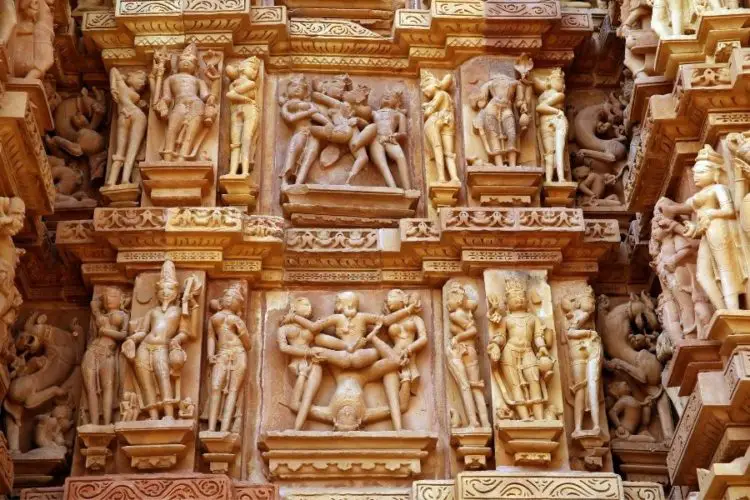The Kama Sutra is an old Indian book that focuses on marriage, courtship, and love making. The text is mainly based on sexuality and eroticism. It talks about different sex positions, advises on how to seduce a partner, and explains the importance of emotional fulfillment during sex. In addition to that, it covers other aspects of ancient Indian life and culture.

The Origin of the Kama Sutra
The text was initially written in Sanskrit, a language used in India between 400 BCE and 200 BCE. In this language, “Kama” means love, pleasure, sex, or desire, and “Sutra” means text or thread. Together, “Kama Sutra” means “teachings on love and desire.” The author of the Kama Sutra is believed to have been Vatsyayana Mallanaga. He was born in India in the state known as Bihar. According to him, the book was written after deep meditation. Apart from authoring the text, not much else is known about Vatsyayana. Very little has been written about him. The very first book on the Kama Sutra was authored in the Abhira Kingdom, which is found near the Sarasvati River.
The actual date the Kama Sutra was written is not clear. Different scholars have expressed varying opinions on the matter.
Translating the Kama Sutra
Ever since its publication, the Kama Sutra has been translated into many Indian and non-Indian languages. The text was first translated into English by Richard Burton, a British polymath, in 1883. In 2012, the very first copy sold at auction for over $14,000.
Early on, people did not understand what the Kama Sutra was all about. However, toward the beginning of the 20th century, the text gained traction in academic disciplines such as medicine, psychology, and ethnology.
In 1995, another English version of the Kama Sutra was published by Indra Sinha, an Anglo-Indian writer. This was the second English translation, and after its publication, more Western people became aware of the Kama Sutra. The focus, however, was on its sexual positions and not on the discussions of love and relationships.
Beyond the Erotic
The scholar Wendy Doniger believed that Burton’s translation was lacking because he did not translate the original written by Vatsyayana; instead, Burton had translated a later version written by Shivaram Parashuram Bhide and Bhagavanlal Indrajit. Their version focused too much on erotic sexual positions and ignored all the other aspects that Doniger felt were more important.
Doniger tried to help readers see the bigger message of the Kama Sutra. In 2016, she wrote a book laying out insights relating to Indian politics, religion, culture, and romance. Her goal was for people to look past the Kama Sutra’s status as a sex manual and see the text from a different angle.
Doniger also views the Kama Sutra as an anthropological picture of ancient Indian society. She places it among the works of other philosophical thinkers like Kautilya and Manu. Additionally, she critiques the text; for example, she notes how the text favors the rich and portrays the poor as sexual victims.
According to Doniger, the Kama Sutra emphasizes the search for a life partner, the nature of love, maintaining one’s love life, and other aspects related to pleasure. Even though Doniger and other scholars largely see it as a text built on ancient Indian culture and Sanskrit literature, the Kama Sutra’s status as a book of sexual positions remains deeply rooted in popular culture.
Kama Sutra Copycats
After the 4th century, many secondary texts were written based on the ideologies contained in the Kama Sutra. Artwork, some of which can be found in Hindu temples, was also created based on the beliefs and ideas in the text.
The Kama Sutra became more popular in the 1900s because of the exotic sexual positions it depicts. In 1977, the novel The Kama Sutra Tango was published. It featured dance routines inspired by the sexual positions discussed in the Kama Sutra.
The Kama Sutra has inspired many, many writers to pen similar books (the book itself has also been pirated countless times). Magazines have written on it extensively. Not only has the Kama Sutra inspired writings and artwork, but some personal products have been named after it and are still sold by businesses to this day.
Advice in the Kama Sutra
The Kama Sutra contains advice for both men and women on sustaining their unions and living happily together. Some examples include:
How to acquire a wife
Under this topic, the text covers things like how to identify the ideal girl, how to earn her trust, why you should take things slow, how to pursue her, how to make her your friend, and how to interpret her different responses.
Rights and responsibilities of a wife
The Kama Sutra advises women on how to be wives, how to lead their lives, what to do in their husband’s absence, their role in the family, and when to take charge.
In this section, the text also talks about how to treat other people’s spouses, the role of courtesans, and practicing the occult, among other things.
Final Thoughts
Unlike what most people believe, the Kama Sutra does not only talk about sex and encourage people to practice different sex positions. Although it does go into detail on erotic sex and sex positions, the text also discusses other critical social aspects and advice to help couples live in unity. According to Vatsyayana, sex is important, but so are other things. The Kama Sutra helps young people understand that, in addition to seeking sexual pleasure, one should live responsibly to avoid any negative consequences that may result from partaking in those pleasures.

